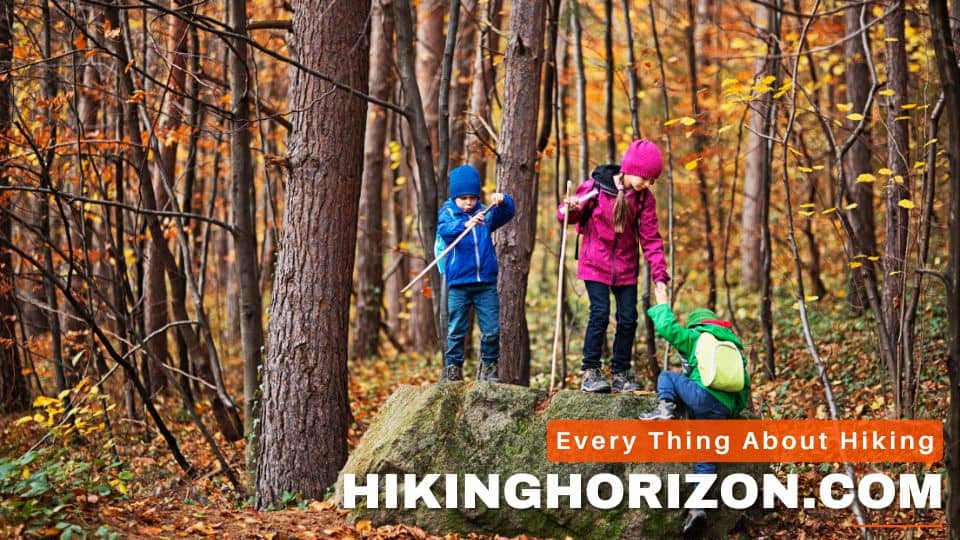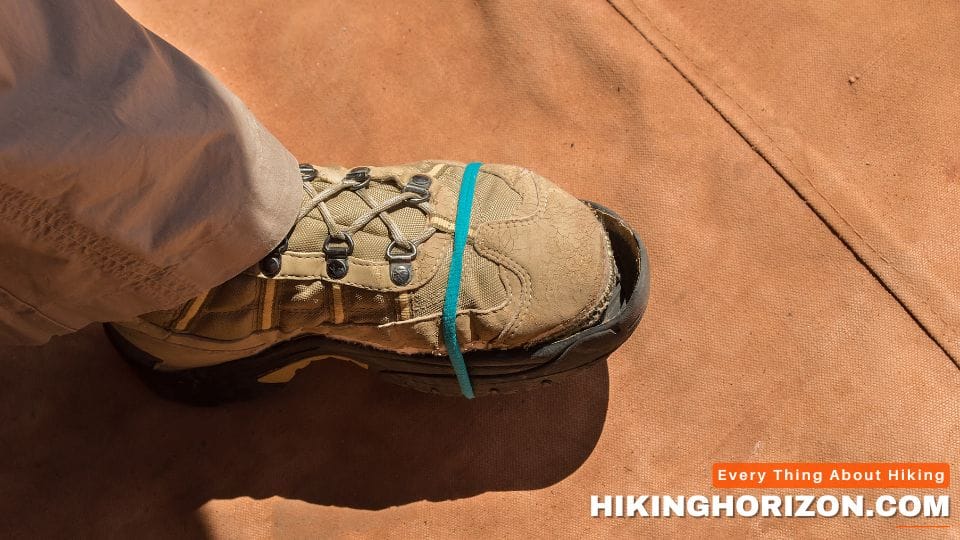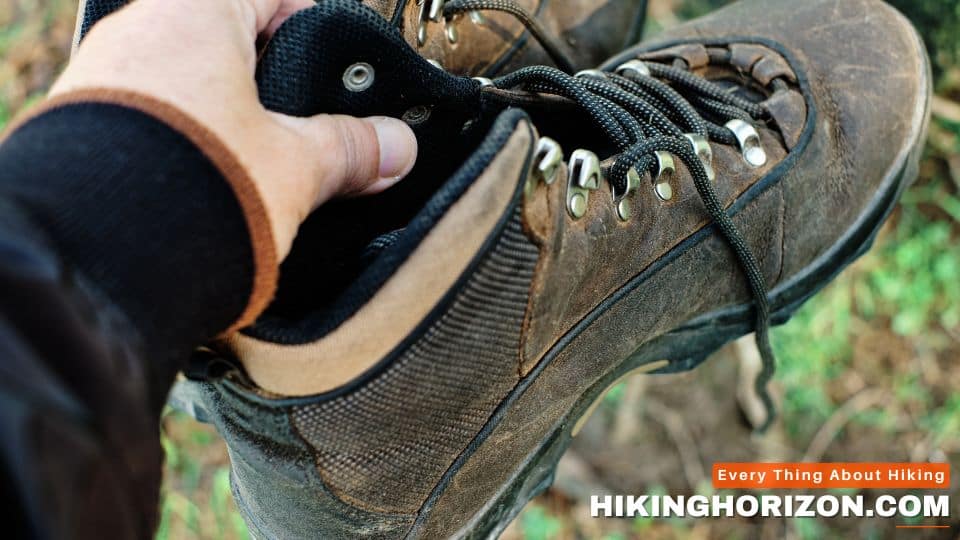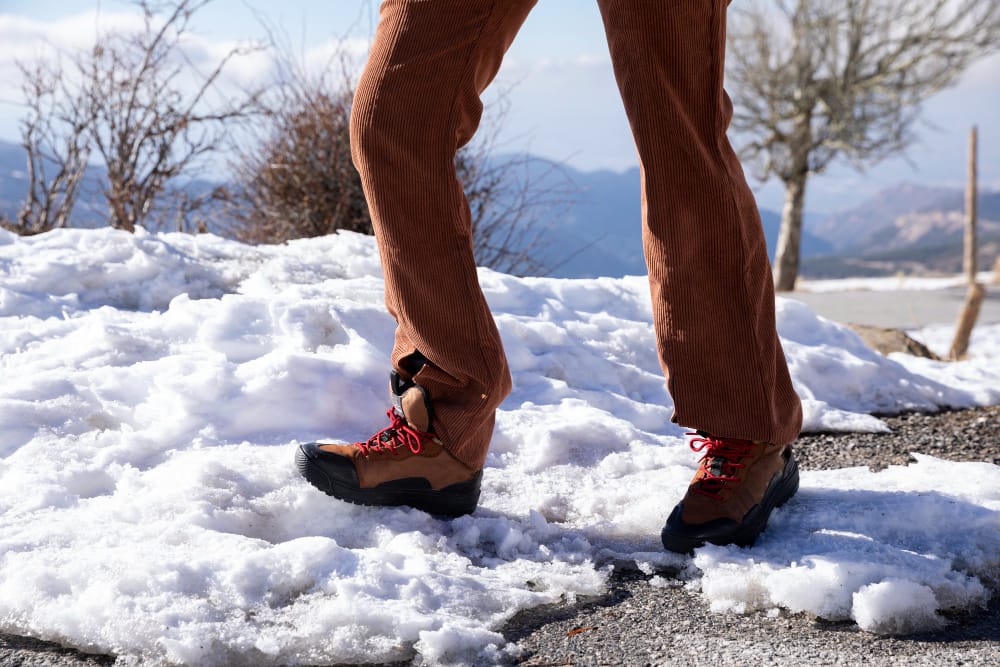
In today’s fast-paced digital world, encouraging our kids to step outside and explore the great outdoors is more important than ever. Hiking is a fantastic way to connect children with nature and provide them with many physical, mental, and emotional benefits. Like many others, you might wonder, What Are Some tips for Hiking with Kids?
Introducing the great outdoors to your kids is a great way to get them moving, exploring, and learning. Hiking is a fun and rewarding activity for people of all ages. With planning and preparation, you can ensure that your next hike with your kids is a safe and enjoyable experience.
With some preparation and planning, hiking can be an enjoyable experience for children of all ages. This article provides 30 hiking tips for kids making the hike fun, educational, and safe.
Table of Contents
1. Start Hiking Early

Taking infants and toddlers out on the trail is never too early. Hiking helps young children develop balance and coordination and builds their curiosity about the natural world. Start with short, easy hikes, and bring plenty of snacks to keep them happy. A child hiking carrier or backpack makes it easier to bring babies along.
“Getting kids outdoors and hiking at an early age sets them up for a lifetime of adventure in nature,” says Maryellen Wright, education director at Yosemite National Park.
2. Hike on Vacations
Make hiking a part of family vacations, whether day hikes or backpacking trips. Kids love exploring new places, and time together in nature creates lasting memories. Pick kid-friendly hikes at national parks and state parks. Work up to bigger hiking challenges as kids get older.
“Hiking on family vacations allows kids to really experience the beauty of places like the Grand Canyon,” says Jesse Duhn, recreation manager at Grand Canyon National Park. “Those shared adventures stick with them for life.”
3. Use a Hiking Carrier
For infants and toddlers who can’t walk far on their own, a hiking carrier lets them tag along on family hikes. Make sure to get a hiking-specific carrier designed for outdoor use. Carriers keep little ones close while leaving parents hands-free on the trail.
“We started using a baby carrier very early on. It was great for hiking with our twins when they were still infants,” says Carla Johnson, an avid family hiker.
Related Article: At What Age Are Infants Safe To Bring Hiking With Their Parents?
4. Bring Healthy Snacks

Pack nutritious snacks like dried fruit, granola bars, crackers, and string cheese to power kids up hills and over long distances. Make sure to bring plenty of water, too. Take regular snacks and water breaks to refuel. Kids tire more quickly than adults, so snacks keep their energy and spirits up.
“Our favorite hiking snacks for kids include applesauce pouches, trail mix and peanut butter crackers,” recommends Lynn Chen, health educator.
5. Take Plenty of Breaks
Make sure to build in plenty of breaks during hikes to let kids rest, have a snack, or explore an area. Kids like to stop and check things out along the trail. Taking breaks makes hiking more interesting and fun for them. It also prevents kids from getting tired or frustrated.
“Taking short breaks allows you to introduce some education or fun into the hike, like finding frogs in a stream,” suggests Stevie Neilsen, environmental education director.
6. Adjust the Pace for Kids
The pace on family hikes should suit the kids, not the adults. Children tire more quickly and need to stop frequently. Go at a relaxed pace and allow kids time to explore and enjoy the hike. If necessary, have adults take turns carrying younger kids to give their legs a rest.
“Hiking with kids means throwing your own pace expectations out the window,” laughs James Chen, an avid hiker. “You have to let them set the pace.”
Related Article: What to Eat Before Hiking? Your Ultimate Guide to Preparing for an Adventurous Trek
7. Hike with Other Families

Joining up with other families can make hiking with kids more fun. Kids enjoy having others to hike and explore with. Adult conversations also help the hike go quickly. Look for family-friendly hiking groups through schools, community centers, churches, or outdoor organizations.
“We love hiking with another family whose kids get along well with ours,” says Tonya Caldwell, mom of two. “The kids hike ahead together and have a blast.”
8. Bring a Toddler Carrier
For children ages 1-3 who can’t hike very far on their own, a toddler carrier lets them walk some of the time while resting their legs. Get a hiking-specific toddler carrier backpack designed for outdoor use on uneven terrain. Practice having the child get in and out at home.
“We’ve used a toddler carrier for all three of our kids. It lets them be more independent on the trail but gives them a break,” says Brandon Mills, father of three.
9. Build Up Distance
Don’t expect young kids to be able to handle long or difficult hikes immediately. Build up the distance and challenges gradually over many shorter hikes. Pay attention to how they handle the mileage. Make sure to turn around before they get too tired.
“Start with a one mile hike and gradually work your way up to longer distances as they build stamina,” advises James Walton, physical education teacher.
10. Celebrate Small Wins

Celebrate when kids complete a new distance or conquer a challenging section of the trail. Cheer them on when they climb that big hill or make it through a rocky patch. This positive encouragement gives them a sense of hiking accomplishment.
“I make sure to high five my kids when they power up and over something tough,” says Julie Sanders, youth leader. “I want them to feel proud of themselves.”
11. Carry Little Kids
If you’re hiking with preschoolers or kindergarteners, be ready to pick them up and carry them when they get tired. Kids this age tire out quickly. Taking turns carrying them prevents frustration and allows you to keep making progress on the trail.
“I either use a child carrier backpack or take turns having my husband or myself carry our 4-year-old son when his energy level drops,” explains Rachel Lee, parent.
12. Push Them a Little
While it’s key to listen when kids say they need to stop and rest, sometimes you can gently push them a bit farther than they think they can go. If they are struggling up a hill, encourage taking just a few more steps. It builds their endurance and confidence.
“I strike a balance between letting my son take breaks but also stretching him a bit on the trail,” says Trevor Adams, father. “It helps him realize he can do hard things.”
30 tips for hiking with kidsxt Here
| Start Hiking Early | Hike On Vacations | Use A Hiking Carrier |
| Bring Healthy Snacks | Take Plenty Of Breaks | Adjust The Pace For Kids |
| Hike With Other Families | Bring A Toddler Carrier | Build Up Distance |
| Celebrate Small Wins | Carry Little Kids | Push Them A Little |
| Bring Treats | Make It Fun | Help Them Feel Proud |
| Let Them Take Photos | Sing Hiking Songs | Use The Kid-Friendly Backpack |
| Bring Extra Hiking Gear | Vary The Hikes ─ Kids Get Bored | Teach About Nature |
| Let Them Choose | Repeat Favorite Hikes | Adjust Distance As Needed |
| Just Get Out Hiking | Believe In Them | Play Hiking Games |
| Share Your Passion | Make Time For Rest | Bring A First-Aid Kit |
13. Bring Treats
Treats like gummies and chocolates aren’t just for after the hike. They can be great motivators on the trail when kids are flagging. Bring surprise treats to give out when kids power over tough sections or reach a viewpoint. It gives them an energy boost when they need it.
“I like to hold out the promise of Skittles or Starbursts as a reward for making it up that big climb ahead,” laughs Mia Caldwell, youth leader.
14. Make It Fun
Keep kids engaged on the trail by making hiking fun. Play trail games like I Spy, 20 Questions, or alphabeting to find things from A to Z. Tell stories, sing songs, and stop to check out cool rocks and plants. The miles will fly by as they play and explore.
“We play lots of games on the trail to keep the kids interested and having a good time,” says Alicia Thompson, parent of three.
15. Help Them Feel Proud
Point out times when kids show perseverance, courage, or accomplishment on the trail. It could be climbing over a big log across the path, fording a stream, or making it up a steep section. Specific praise helps boost their hiking confidence.
“When my daughter made it up a tough scramble section, I made sure to praise her determination,” says Mike Davis, Scout leader. “That sense of accomplishment sticks with kids.”
16. Let Them Take Photos

Equipping them with a camera or a cell phone encourages them to document the journey and immortalize the exciting moments and fascinating discoveries they encounter along the trail. Taking photos engages them in telling the story of the hike. They’ll love looking through the pictures afterward and showing them to their friends.
“We always bring my daughter’s kid-friendly camera, and she takes some amazing shots out in nature,” says Sierra Dunn, photographer.
17. Sing Hiking Songs
Sing silly but classic hiking songs together like “The Bear Went Over the Mountain” or “The Ants Go Marching.” Making up your own songs about the hike or things you see along the trail also taps into kids’ creativity. Singing passes the time and lifts spirits.
“We have a family tradition of making up songs on every hike, usually pretty goofy ones,” laughs Noah Lambert, guitar player. “The kids love leading the songs.”
18. Use the kid-friendly backpack
Ensure kids have sturdy hiking shoes or boots that fit well and are broken in before a big hike to prevent blisters. Essential gear like a backpack, water bottle, sunscreen, and hat should also fit them properly. Gearing up for the trail conditions helps them feel prepared.
“I take my son to the outdoor store and have him try on hiking shoes and boots before we buy,” explains Lily Chang, gear expert. “Properly fitted gear prevents injuries.”
19. Bring Extra hiking Gear

Pack extra layers and rain gear for kids in your backpack in case the weather shifts. Kids can cool down or tire faster. Having dry, warm extra clothes and gear keeps them comfortable in changing conditions. A spare pair of socks can also help with blister issues.
“We always carried extra fleeces and rain ponchos for our girls in the pack along with extra socks,” says Mark Jones, Eagle Scout leader. “Being prepared for the unexpected is key with kids.”
20. Vary The Hikes ─ kids get bored
Switch up the scenery on your family hikes to maintain kids’ interest. Try hikes with water features, chances to climb on rocks, or opportunities to see wildlife. Visiting new parks and trails exposes them to different landscapes and experiences.
“We try to mix up the terrain on our family hikes – some hilly, some flat, some with creeks or lakes,” explains James Miller, forest ranger. “Variety keeps the kids excited to hike.”
21. Teach About Nature
Turn hikes into learning adventures by teaching kids about nature. Stop to identify plants and animals. Look for animal tracks and analyze scat. Examine colorful minerals or unique rock formations. Kids love discovering new things in the outdoors.
“I like to carry a pocket nature guide to help my kids learn all about the plants and wildlife we encounter,” says Clara Evans, naturalist. “Their curiosity makes every hike an adventure.”
22. Let Them Choose
Give kids some power to choose elements of the hike, like lunch spots or stopping points. Giving them a sense of control makes the hike more fun. Just provide clear choices appropriate for their age and experience level.
“I’ll ask my daughter if she wants to hike to the ridge or the lake when we come to a trail split,” says Daniel Brown, outdoor educator. “It helps her feel part of the decision making.”
23. Repeat Favorite Hikes

It’s okay to repeat favorite family hikes. Kids love returning to trails and seeing their progress in conquering sections that used to be hard. They remember fun elements like a creek crossing or viewpoint. Mastering a hike builds confidence.
“My son always wants us to return to this one state park trail,” says Tyler Cramer, dad of two. “It has lots of rocks he can climb on, and he loves the accomplishment of finishing it.”
24. Adjust Distance as Needed
Be flexible with distance goals when hiking with kids. They may fly through an easier section and then hit a wall. Don’t push them to finish a longer hike if they are struggling. Save some distance for next time if needed.
“With my daughter, pacing is everything on a hike. I adjust our route and turnaround time based on her energy that day,” advises Mark Jefferson, wilderness guide.
25. Just Get Out Hiking
Don’t put off hiking with kids just because you can’t tackle big mileage or an epic summit. Short, simple hikes count, too. Focus on time spent outdoors together rather than distance or difficulty. Set non-intimidating goals based on kids’ abilities.
“Some of my favorite family hikes have just been a quick loop trail near home to get us outside,” says Samantha Lee, parent. “Short hikes are still special.”
26. Believe in Them
Make sure to express confidence in kids’ hiking abilities, even when they doubt themselves on a tough section. Remind them of past successes. Your trust in their skills helps push them forward when the going gets rough. Offer frequent encouragement.
“When my daughter says she can’t make it up a hill, I remind her of the big hills she’s conquered before,” says Tyler Miller, wilderness therapy guide. “That gives her a needed dose of I-can-do-this confidence.”
27. Play Hiking Games
Incorporate games into your family hikes to add fun and take kids’ minds off the mileage. Play trail tag, hunt for treasures, or spot hikers doing certain things. Make-up games using the terrain, like hopping from rock to rock. Laughter makes the miles disappear.
“We like to play the alphabet game and find things starting with each letter as we hike,” suggests Lily Rodriguez, third-grade teacher. “It turns hiking into a fun adventure for the kids.”
28. Share Your Passion
Enthusiasm is contagious. Share your passion for hiking and being outdoors with your kids. Let them know how happy it makes you to be with them in nature. Your excitement will rub off on them. Create family hiking traditions to build that shared love.
“I tell my kids stories of my favorite childhood hiking memories with my family. My passion has become their passion,” says Frank Hughes, hiking dad.
29. Make Time for Rest
Balance activity with rest for a pleasant family hiking experience. Make time to stop and have a snack or explore an area. Choose shady spots to take breaks. Carry little ones when needed. Building in rest prevents grumpiness.
“We make sure to take sit-down snack and water breaks in the shade so the kids recharge,” advises Julie Smith, recreation therapist. “Rest is key to happiness on the hike.”
30. Bring a First-Aid Kit
Pack a basic first-aid kit on family hikes in case of minor injuries like scrapes and blisters. Essentials include bandages, antibiotic cream, bug bite relief, pain reliever, and moleskin for blisters. Being prepared gives peace of mind.
“Having a first-aid kit has come in handy for warding off blisters after my son’s old boots caused a flare up,” says Sierra Campbell, nurse. “It’s a must-have precaution when hiking with kids.”
How to Leave No Trace is Important for Kids?
Taking your kids hiking on a trail is a great way to get them excited about the outdoors. However, it’s important to teach kids Leave No Trace principles so they learn how to enjoy nature responsibly. Make sure your kids don’t leave trash, food scraps, or other items behind that could impact plants and wildlife. Pick up any litter you find and explain to kids how even small things can add up and harm ecosystems. Practice Leave No Trace by sticking to designated hiking trails and not wandering into sensitive areas. Avoid picking flowers or disturbing vegetation. Teach kids to leave nature as they found it so the next hikers can enjoy it too.
You can introduce Leave No Trace to kids through fun activities like scavenger hunts for trash or games identifying sustainable behaviors on the trail. Give kids positive reinforcement when they demonstrate Leave No Trace in action. Set a good example by modeling Leave No Trace yourself. Make the concepts concrete for kids by explaining how leaving trash behind can hurt animals or how wandering off trails can damage plant life. Leave No Trace is an important ethic for kids to learn so they can be responsible hikers and develop an appreciation for protecting natural spaces. The habits they gain now can last a lifetime.
15 Tips for Hiking with Kids in Winter

If you plan and prepare properly, hiking with kids in winter can be a magical experience. Snow-covered landscapes provide a wonderland for outdoor adventures. Use these 15 tips to keep your family safe, warm, and having fun on winter hiking trips.
1. Dress in Layers
Dress kids in synthetic or wool base layers that wick away sweat. Top with windproof and waterproof outer layers like jackets and snow pants. Bring extra layers for added warmth, like fleece jackets and hats. Shed layers as you heat up, then add them back as needed.
“Following the layering system is crucial for keeping kids comfortable in winter weather,” advises Mark Chen, outdoor educator.
2. Choose Insulated Boots
Look for waterproof winter hiking boots with insulation to keep kids’ feet warm and dry in the snow. Break boots in before your winter hike to prevent blisters. Bring extra socks in case socks get wet. In severe cold, add boot heaters or toe warmers for extra insulation.
“We outfit our kids in warm yet breathable winter boots for snowshoeing and winter hiking,” says Sierra Adams, gear shop owner.
3. Pack Hand and Foot Warmers
Keep kids’ hands and feet toasty by packing disposable hand and foot warmers. When inserted in gloves, boots, or pockets, these air-activated warmers provide up to 10 hours of heat. They offer an easy way to warm up cold fingers and toes quickly.
“We always bring extra hand and foot warmers in case someone gets an extra chill during a winter hike,” recommends Tyler Jefferson, Scout leader.
4. Fuel Up Before and During
Ensure kids eat a high protein and complex carb pre-hike meal for energy. Pack nutritious snacks like trail mix, protein bars, and dried fruit to power them during the hike. Well-fueled kids stay warmer and happier in cold temperatures.
“Providing lots of food for winter hiking is a must to generate warmth and energy,” says Sierra Thompson, registered dietitian.
5. Stay Hydrated
Dehydration comes on quickly in the icy air. Ensure kids drink plenty of water before, during, and after the hike. Add an insulated hydration reservoir to backpacks so drinking water won’t freeze. Bring a thermos with a warm beverage as well.
“We have our kids drink frequently from hydration bladders in their packs,” says James Lee, wilderness guide. “Staying hydrated is so critical in winter.”
6. Apply sunscreen
Don’t skip the sunscreen just because it’s cold. Snow reflects sunlight, increasing UV exposure. Choose a lip balm and sunscreen with at least SPF 30. Reapply if outside for extended periods. Protect kids’ eyes with UV-blocking sunglasses.
“Kids still need sunscreen on bright winter days since the sun’s rays reflect off the snow,” reminds Lily Hughes, dermatologist.
7. Watch for Hypothermia
Learn to recognize early signs of hypothermia like shivering, fatigue, confusion, and loss of coordination. Act quickly if hypothermia sets in by adding insulation layers, hydrating, and getting the child indoors. Prevent hypothermia by packing proper clothing and avoiding exhaustion.
“With kids, you have to be hyper aware of temperature regulation on winter hikes,” warns Mark Davis, search and rescue volunteer. “Catch hypothermia early.”
8. Bring Extra Gear
Carry backup winter gear for kids in case gloves get wet or extra jacket layers are needed. Toss in chemical hot packs for emergency hand and foot warming. Prepare for the worst so you don’t have to cut the hike short due to cooling.
“I always pack extra gloves, mittens, hats and fleece layers in case kids’ gear gets wet or they need more insulation,” says Julie Sanders, mom of two.
9. Choose Calorie-dense Foods
Pack winter hiking foods that provide a concentrated dose of calories and nutrition. Go for fatty proteins like nuts, peanut butter, and jerky or dried meats. Add in calorie-dense dried fruits like dates, prunes, raisins and cranberries. These fuel kids’ internal furnaces.
“Calorie-dense foods that kids can snack on give them an energy surge to generate critical body heat in the cold,” explains James Miller, sports nutritionist.
10. Check Conditions
Take the time to check both the weather forecast and trail conditions to ensure a safe and enjoyable adventure. Pick lower elevation hikes to avoid dangerous ice and snowpack. Have proper winter traction gear like microspikes and know how to use them. Turn back if conditions deteriorate during your hike.
“We monitor weather reports leading up to winter hikes and are prepared to postpone if needed for safety,” says Mark Taylor, avalanche forecaster.
11. Keep Moving
Avoid letting kids sit or stand in one place too long. Do it while walking or incorporating movement games when taking a snack break. Getting cold quickly leads to grumpiness. Gentle activity generates body heat and warmth when resting.
“You’ve got to keep kids moving on winter hikes to maintain body temperature,” says James Chen, wilderness therapy guide. “Even snack breaks should involve walking or moving.”
12. Bring a Thermos
Make the hike more fun by bringing a thermos filled with a warm, kid-friendly beverage like hot chocolate, apple cider, or chocolate milk. Warm drinks boost body heat while providing a tasty treat. You can even add instant cocoa packets and cups.
“Thermoses filled with warm drinks bring comfort and joy to winter hiking with kids,” says Julie Thompson, mom of two. “It’s their favorite part of our adventures.”
13. Make It Fun
Keep kids engaged and motivated on winter hikes by incorporating fun activities. Bring a sled or snow tubes to glide down hills. Make a snowman or snow angels. Look for animal tracks and go snowshoeing. Turning it into play makes the cold more bearable.
“We always bring a sled to take turns sliding down hills on our winter hikes,” says Noah Lambert, dad of three. “It adds so much extra fun for the kids.”
14. Take Frequent Breaks
Frequent snacks and rest breaks help revitalize and warm up kids on cold hikes. Find sheltered spots out of the wind to stop. Swing arms in circles to get blood flowing before moving on. Adjust pace and break duration based on kids’ needs.
“I closely monitor all my kids for signs they need a warming break,” explains Sierra Lee, mom of two. “Short stops recharge them in the cold.”
15. Reward Them
Keep kids motivated by promising small rewards for completing sections of the hike. Give out candy, stickers, or hot cocoa when they summit a hill or complete a certain distance. Having something to look forward to pushes them along.
“I bring little toys and treats to give my kids after reaching hike milestones,” says Tyler Hughes, Scout leader. “Small rewards incentivize them in winter.”
tips for winter hiking with kids
| Tip | Description |
|---|---|
| Dress in layers | Use a layering system with synthetic or wool base layers, insulating mid-layers, and waterproof/windproof outer layers. Shed and add layers as needed. |
| Choose insulated boots | Select waterproof winter boots with insulation to keep feet warm and dry. Break them in ahead of time. |
| Pack hand and foot warmers | Bring disposable air-activated warmers for quick warming of hands and feet. Put them in gloves, boots, pockets. |
| Fuel up before and during | Eat a high protein, high carb pre-hike meal. Bring nutritious, high-calorie trail snacks. |
| Stay hydrated | Drink plenty of water before, during and after. Use an insulated reservoir so water doesn’t freeze. |
| Apply sunscreen | Use SPF 30+ sunscreen and lip balm since snow reflects UV rays. Wear sunglasses. |
| Watch for hypothermia | Know the signs like shivering, confusion, fatigue. Add layers, hydrate, get indoors if it occurs. |
| Bring extra gear | Carry spare winter clothes and gear in case primary layers get wet or kids need more insulation. |
| Choose calorie-dense foods | Pack high-fat, high-calorie snacks like nuts, nut butter, jerky and dried fruit. |
| Check conditions | Monitor weather and trail conditions. Pick lower elevation hikes. Use proper winter traction gear. |
| Keep moving | Avoid letting kids sit still too long. Incorporate gentle activity into snack breaks to generate warmth. |
| Bring a thermos | Fill a thermos with warm kid-friendly drinks like hot chocolate or apple cider. |
| Make it fun | Do winter activities like sledding, making snowmen, looking for animal tracks. |
| Take frequent breaks | Stop often for snacks, hydration, and to warm up kids. Find sheltered spots. |
| Reward them | Promise small treats or rewards when kids complete |
FAQs About "tips for hiking with kids"
What age is the best for kids to start hiking?
Kids as young as 4 years old can start enjoying hiking on kid-friendly trails. Start with short, easy hikes and let the kids set the pace. Make the first hike exciting by playing hiking games with your kids.
How to handle kids’ fatigue while hiking?
Kids often get tired more quickly than adults on the trail. Take breaks often, and keep them hydrated and fueled with kid-friendly snacks. Distract them from fatigue by talking about what you see and playing hiking games. If needed, shorten the hike or turn back early.
What kind of food is best for kids during hiking?
Pack kid-friendly hiking snacks like trail mix, granola bars, fruit snacks, and sandwiches. Bring plenty of water and electrolyte drinks to stay hydrated. Choose calorie-dense snacks to power their hiking.
How can I help my kids learn nature skills while hiking?
Point out plants and animals you see on the trail. Do a scavenger hunt for different objects like pinecones or acorns. Teach older kids to use field guides. Stop at the waterfall or scenic overlooks and discuss geology and ecosystems. Make it fun and hands-on.
How do I prepare my child for hiking?
Help kids pick out a good daypack, hiking shoes, and rain gear. Pack whistles and snacks. Explain trail etiquette like staying on the path. Get kids excited by reading hiking books and showing pictures of where you’ll go. Start with short hikes and work up to longer distances.
What age should kids start hiking?
Kids can start enjoying hiking as young as 4, depending on the child. Start with flat, short trails less than a mile. Wait until 6-8 for more challenging hikes. Build up distance gradually as kids condition for longer hikes.
How many miles can a child hike a day?
Most kids can hike 2-4 miles per day, but mileage varies by age and terrain. Start with 1 mile or less for younger kids. Take frequent breaks. Older kids in good shape may be able to handle 5-6 miles on flatter trails. Let the kids set the pace.
How much weight should kids carry hiking?
Aim for no more than 10-15% of their body weight. Lighten their load by having adults carry most gear and water. A hydration pack is ideal for older kids to carry some water.
What age can kids go in hiking backpacks?
Hiking backpacks are great for carrying babies and toddlers up to about 3 years old comfortably. Older kids will likely prefer walking themselves.
Conclusion
Creating enriching hiking experiences for kids takes some advance preparation, patience, and TLC along the trail. Keeping their abilities, safety, and enjoyment at the forefront ensures hiking remains a positive time together in nature. Though hiking with kids sometimes poses challenges, the rewards of fresh air, exercise, shared adventures, and future outdoor enthusiasts make the effort well worth it. Families can craft treasured memories of exploring the trails with ideas like these hiking tips.

SARAH LEE
Sarah has been hiking for over five years and is passionate about promoting the mental and emotional benefits of spending time in nature. She has written several articles on the topic and strongly advocates hiking as a form of therapy. Sarah is also a certified yoga instructor, often incorporating yoga and mindfulness practices into her hiking trips. She is dedicated to providing accurate and up-to-date information on trail conditions, difficulty levels, and must-see sights.

SARAH LEE
Sarah has been hiking for over five years and is passionate about promoting the mental and emotional benefits of spending time in nature. She has written several articles on the topic and strongly advocates hiking as a form of therapy. Sarah is also a certified yoga instructor, often incorporating yoga and mindfulness practices into her hiking trips. She is dedicated to providing accurate and up-to-date information on trail conditions, difficulty levels, and must-see sights.



